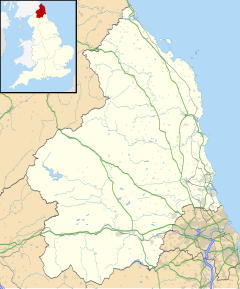Carham or Carham on Tweed is a village in Northumberland, England. The village lies on the south side of the River Tweed about 3 miles (5 km) west of Coldstream. According to the United Kingdom Census 2011, it is the place in England with greatest proportion of Scottish-born people, at approximately 33%.
| Carham | |
|---|---|
 St Cuthbert's church | |
Location within Northumberland | |
| Population | 346 (2011 census)[1] |
| OS grid reference | NT795385 |
| District | |
| Shire county | |
| Region | |
| Country | England |
| Sovereign state | United Kingdom |
| Post town | CORNHILL-ON-TWEED |
| Postcode district | TD12 |
| Dialling code | 01890 |
| Police | Northumbria |
| Fire | Northumberland |
| Ambulance | North East |
| UK Parliament | |
Etymology
editCarham has generally been etymologised as an Old English place-name. The first syllable would be from carr 'rock', and the second either a dative plural ending (the whole name having been carrum '(at the) rocks') or the word hām ('homestead'). However, the twelfth-century chronicler Richard of Hexham appears not to have considered the name an English one, so it may actually come from Cumbric *kair 'fortification'.[2]
History
editNear to Carham are the extensive remains of Early British camps and a bronze sword, now in the British Museum, discovered in the nearby Tweed.[3]
Carham on the Tweed, where a stream divides Northumberland from Scotland, was the scene of two battles in Anglo-Saxon times.[4]
In 833 the Danes fought the English, and the English were routed. Leland tells us that
in the 33rd year of Ecbright the Danes arrived at Lindisfarne and fought with the English at Carham where Eleven Bishops and two English Countes were slayne, and a great numbre of people.
A field between the glebe and Dunstan Wood, where bones have been from time to time disinterred, is probably the site of the battle.[3][5]
In 1018 the Battle of Carham between the Kingdom of Scotland and the Northumbrians resulted in a Scottish victory. The fact that the Tweed is the border between Scotland and England can be traced to the outcome of this battle.[6]
James VI of Scotland crossed the border on 26 April 1588 and visited Carham.[7]
Carham Hall
editCarham Hall, located NE of the hamlet, was a 14th Century tower house built to defend against border reivers. The first house was built by the Compton family in 1755. It was extended by Richard_Hodgson-Huntley in 1870 and again by architect James Bow Dunn in 1920.
Governance
editCarham is in the parliamentary constituency of Berwick-upon-Tweed.
Religious sites
editThe church is dedicated to St Cuthbert.[8]
Notable people
edit- John Stark CBE KPM (1865–1940), a British police officer, Assistant Commissioner of the City of London Police from 1925 to 1933.
References
edit- ^ "Parish population 2011". Retrieved 3 July 2015.
- ^ Bethany Fox, 'The P-Celtic Place-Names of North-East England and South-East Scotland', The Heroic Age, 10 (2007), http://www.heroicage.org/issues/10/fox.html (appendix at http://www.heroicage.org/issues/10/fox-appendix.html).
- ^ a b Ridley, Nancy (1966). Portrait of Northumberland (reprint ed.). London: Robert Hale. OCLC 503957631.
- ^ British History Online
- ^ Hugill, Robert (1931). Road Guide to Northumberland and The Border. Newcastle upon Tyne, England: Andrew Reid & Company, Limited.
- ^ Daly, Rannoch (2018). Birth of the Border, The Battle of Carham 1018 AD. Alnwick: Wanney Books
- ^ Calendar State Papers Scotland, vol. 9 (Edinburgh, 1916), p. 557.
- ^ Purves, Geoffrey (2006). Churches of Newcastle and Northumberland. Stroud, Gloucestershire, England: Tempus Publishing Limited. p. 173. ISBN 0-7524-4071-3. Archived from the original on 13 January 2016.
External links
edit- The Official Carham Parish Website
- GENUKI (accessed: 19 November 2008)
